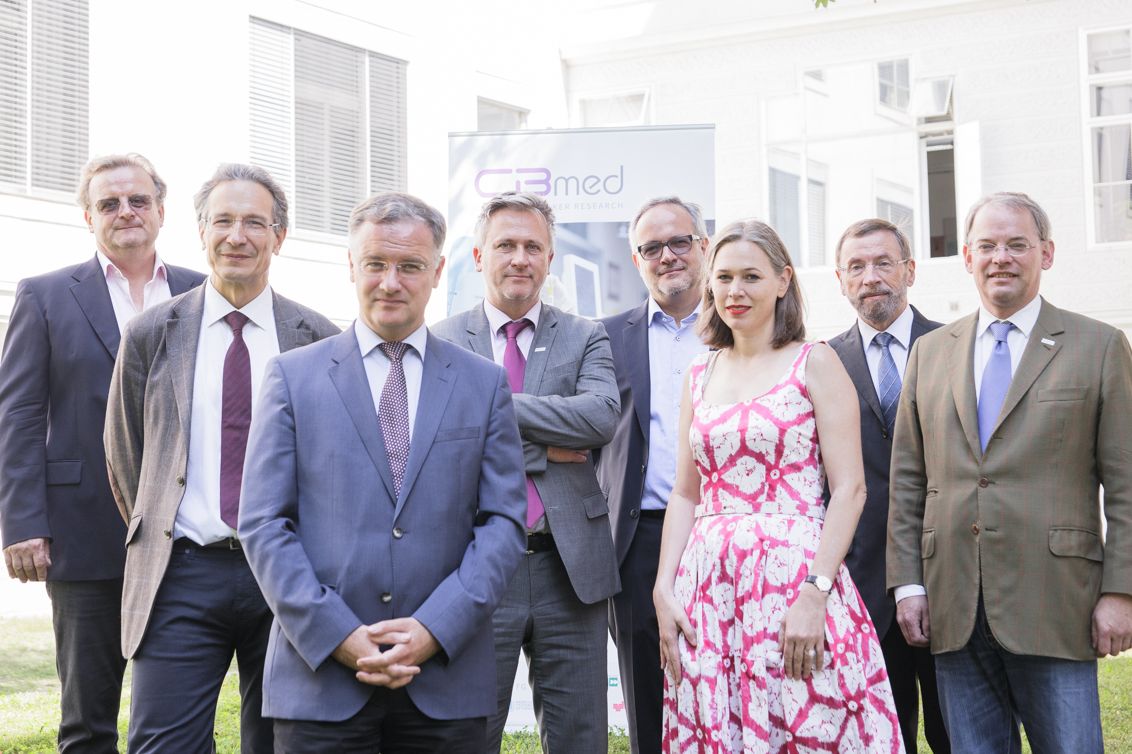
(Vienna, 08 July 2016) – The Austrian research center CBmed (Center for Biomarker Research in Medicine) officially opens a new Core Lab at the Medical University of Vienna. The proteomics laboratory uses completely new methods to identify new biomarkers. This represents a huge step forward on the path to personalized medicine, particularly for the treatment of cancer patients.
"Over the last few years, the knowledge that each person responds differently to each treatment has become more widespread. It is the long-term goal of medical research to make personalized, tailor-made treatment available to each individual patient," explains Thomas Pieber, Scientific Head of the CBmed GmbH research center. "An important area of research along this path is the analysis of biomarkers, which are biologically measurable units such as enzymes, hormones or genes, measured in human tissue samples. We are researching completely new methods in our so-called Core Lab, in order to be able to provide targeted diagnosis and tailored treatment to our patients as quickly, considerately and efficiently as possible," continues Pieber. The CBmed research center regards the Medical University of Vienna as the ideal location for the new – and now the sixth – “Core Lab", specializing in proteomics (analysis of all proteins in a cell).
Personalized medicine is the most significant trend in 21st century medicine
"MedUni Vienna aspires to provide its patients with state-of-the-art treatment. "Personalized medicine" is the most significant trend in 21st century medicine. New therapies are no longer focused on pharmaceuticals but are applied and developed in a way that focuses on the patient. Molecular characterization of diseased and healthy tissue plays a decisive role in this. MedUni Vienna therefore has great expectations of this biomarker research with CBmed,” explains Markus Müller, Rector of the Medical University of Vienna.
In vivo imaging: Identifying cells and metabolic processes externally
The new “Core Lab 2" of the CBmed research centre at MedUni Vienna will work using proteomics (proteome = protein structure). It is based on sequencing of the whole human genome in 2001. Thanks to in-vivo imaging, it is possible to detect tumors in the body without the need for a biopsy, that is to say non-invasively – as long as the corresponding biomarkers are known. This method can also be used to image metabolic processes. This involves injecting radioactive marker molecules into the patient. Just as a key fits into a lock, the markers find the matching molecule on the surface of the tumor and collect there. The exact nature, position and size of the tumor can then be imaged at high resolution using Positron Emission Tomography (PET) – also a huge advantage for observing patients prior to an operation. "The realization that tumors are more complex than was previously thought and also have more molecules, is relatively new. Due to intertumoral heterogeneity, a single tissue sample is often not representative.
Our aim is to define as many therapeutic target molecules as possible, so that, in future, we will be able to detect all types of tumors without the need for invasive procedures to take tissue samples," explains Lukas Kenner, experimental pathologist at MedUni Vienna. Using software from the Viennese company TissueGnostics, tumors can be broken down in a model, and also in reality, into individual molecules and the proteome analyzed. In contrast to CBmed’s Core Lab 1, which only works with fresh samples, Core Lab 2 will analyze paraffin samples to find new markers – a complete first, because, until recently it was not technically possible to analyze the entire proteome from paraffin samples. The aim is to automate the method of analysis in order to reduce costs and to be able to map patients' histories over a period of years.
Hundreds of proteins can be analyzed at the same time using MALDI-MSI
Matrix-assisted Laser Desorption Ionization (MALDI) is a method for ionizing molecules. "This method, which we have been using in the first Core Lab in Vienna for some time now, enables us to analyze hundreds of proteins, rather than only five, as previously. We therefore hope to find new biomarkers more quickly," says Rudolf Oehler, MedUni Vienna. The new method is being developed in collaboration with TissueGnostics, which contributed the software. "What is new is that this development enables us to analyze tissue without using antibodies," says Oehler. In the next step, individual cells are extracted from the samples – as in an in-vitro fertilization procedure, a software-controlled glass capillary is inserted into the tissue and the required cells sucked out together with a solvent and then analyzed – for example in a mass spectrometer. "Thanks to this new MALDI-MSI process, we will be able to compare lots of different tissue samples with each other and find important biomarkers," hopes Oehler. A relatively new method of treating cancer is cancer immunotherapy using Immune Checkpoint Inhibitors (ICI). Approximately one third of patients respond to this, unfortunately still very expensive, treatment, which is currently successfully used for treating black skin cancer - and are completely cured. Oehler: "If we can find biomarkers that can tell us in advance whether a treatment will help or not, that would be a breakthrough with enormous savings potential, because it will then only be used on people we know it will work for."
Ideally, the development of specific biomarkers will mean that patients can receive customized treatment.
CBmed GmbH
CBMed is owned by the Medical University of Graz (43.5%) the Medical University of Vienna (20%), the Technical University of Graz, Joanneum Research and the Austrian Institute of Technology. The consortium comprises 34 industrial and 23 scientific partners.